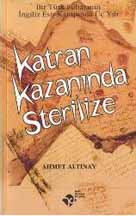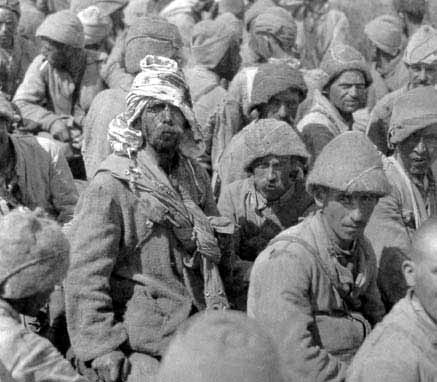|
|
 |
|
"Katran
Kazaninda
Sterilize" |
We often hear how badly British POWs were treated by the
Turks. (Sometimes we even hear how well they were treated in Gallipoli.)
But how were Turkish POWs treated by the Brits?
The source of the following article is a 2004 book (pictured at right and
available here) that is not known to me. But if the story is
accurate, it's pretty amazing going, folks. Nothing the Turks could have done
to the British POWs could possibly compare with this.
For the original article, in Turkish, click
here.
Ermeni diasporasinin karalama
kampanyalari hizla suruyor.
Saldirinin muhatabi Turkiye Cumhuriyeti Devletinden ise ciliz birkac
karsi cikistan baska tepki yok.
Oysa, elimizde oylesine onemli belgeler var ki...
Ornegin bu yazida anlatacaklarimi. Cogumuzun bildigini de sanmiyorum.
Karamanli yedek subay Ahmet Altinayin gunlugunu su yuzune cikaran Ahmet
Durunun, imge yayinlarindan cikan "Katran Kazaninda Sterilize"
adli kitabindan...
Birinci Dunya Savasinda Ingilizlere, 150 bin askerimiz esir dustu. Bu
askerlerden bir kismi da Misirin Iskenderiye sehri yakinlarinda bulunan
Seydibesir Usare Kampina hapsedildi. Kampin tam adi, "Seydibesir
Kuveysna Osmanli Useray-i Harbiye Kampi" idi. Bu kampta, 1918de
Filistin cephesinde esir dusen 16. Tumenin 48. Alayina bagli Osmanli
askerleri tutuluyordu. 12 Haziran 1920ye kadar iki yil boyunca her turlu
iskence, eziyet, agir hakaret ve asagilamaya maruz kaldilar.
Bu insanlik disi muamelenin nedeni ise Ermeniler idi...
Kamptaki, Turkce bilen Ermeni tercumanlarin yalan, yanlis cevirileri ve
kiskirtmalari nedeniyle, kamplarin Ingiliz komutanlari, azili Turk dusmani
kesilmislerdi.
***
Savas bitmisti. Ancak, kamptaki agir kosullar nedeniyle olenler disindaki
askerleri teslim etmek, Ingilizlerin isine gelmiyordu. Cunku, olasi yeni
bir savasta, bu askerlerin yeniden karsilarina cikabilecekleri, Ermeniler
tarafindan, Ingilizlerin beyinlerine islenmisti. Cozum toplu katliamdi...
Askerlerimiz, mikrop kirma bahanesiyle, sungu zoruyla dezenfekte havuzlarina
sokuldu. Ancak suya normalin cok uzerinde krizol maddesi katilmisti.
Mehmetcik, daha ayagini soktugunda, asiri krizol maddesi nedeniyle
haslaniyorlardi. Ancak Ingiliz askerleri dipcik darbeleri ile askerlerimizin
havuzdan cikmalarina izin vermiyorlardi.
Mehmetcikler, bele kadar gelen suya baslarini sokmak istemedi. Ancak bu kez
Ingilizler havaya ates etmeye basladi. Askerlerimiz, olmemek icin comelerek
baslarini suya soktular.
Ancak basini sudan kaldiran artik goremiyordu. Cunku gozler yanmisti...
Disari cikanlarin halini goren siradaki askerlerimizin direnisleri de fayda
etmedi ve 15 bin askerimiz kor oldu.
***
Bu vahset, 25 Mayis 1921 tarihinde TBMMde gorusuldu. Milletvekilleri Faik
ve Seref beyler bir onerge vererek, Misirda esirlerin krizol banyosuna
sokularak 15 bin vatan evladinin gozlerinin kor edildigini, bunun faili olan
Ingiliz tabip, garnizon komutani ve askerlerinin cezalandirilmasi icin TBMMnin
tesebbuse gecmesini istediler.
Tabii ki yeni kurulan devletin bin turlu sorunu vardi. Bu hesap sorma isi de
unutuldu gitti.
***
Ama onlar unutmuyorlar... Kendi ihanetlerini bile soykirim ambalajina sarip,
dunya kamuoyuna sunuyorlar. En uzucu olani da malum birilerinin, bu karalama
kampanyalarina canak tutmasi...
Sinan AYGUN - ATO Baskani
[Close]
Another look at this chapter (in Turkish) may be found
on this page.
With great thanks to the translation of Ms. Damla Ozdemir. (A few translation
notes follow.) Thanks also to reader M. Niyazi Odyalmaz, who brought this
story to my attention.
|
|
|

These Turkish POWs surrendered to Lt.-General Stanley Maude,
after
the capture of Baghdad in March 1917. Perhaps some of these very men
were among the victims in the story you will read.
|
Dispersed Armenians defamation campaigns are spreading with full speed.
However, there is no reaction but a few weak objections from the accused (1) Turkish
Republic Government.
Yet we have such important documents
For example, I dont think most of us know the things I am going to tell in this
article. From the book Katran Kazanında Sterilize ("Sterilized in
Tar Cauldron") by Imge Publications, written by Ahmet Duru who revealed the diary of
the sub-lieutenant (2) Ahmet Altinay from Karaman
In WWI, 150 thousand of our soldiers were captured by the British. And some of these
soldiers were imprisoned in Seydibesir Useray-i Harbiye Camp (3) near the city of
Alexandria in Egypt. The full name of the camp was Seydibesir Kuveysna Osmanli Useray-i
Harbiye (4) Kampi. In this camp, the Ottoman soldiers of 16th Divisions 48th
Regiment who were captured at the Palestine fronts in 1918 were interned. For two years
until June 12th, 1920, they were subjected to any kind of torture, oppression, heavy
insults and humiliation.
The reason for this inhumane treatment was the Armenians.
The British commanders of the camp, because of the wrong, mendacious translations and
provocations of Armenian translators who knew Turkish, had become fierce Turk enemies.
***
The war was over. Nevertheless, to release the soldiers besides the ones who died because
of heavy conditions in the camp was not to the benefit of the British. Because the British
were brainwashed by Armenians, being told that in a potential new war they could come up
against these soldiers again. The solution was massacre
Our soldiers, forced by bayonets, were put in disinfection pools with the excuse of wiping
out germs. But the chemical, krizol, was added a lot more than normal in the water. Even
just when they put their feet, our soldiers got scalded. However, the British troops didnt
let them get out of the pool by threatening with rifles (5).
Our soldiers didnt want to put their heads under the water that reached waist level.
But then the British started shooting in the air. Our soldiers knelt and put their heads
under water not to die.
But the ones who got their heads out of the water couldnt see any more. Because the
eyes were burned
The resistance of our soldiers who saw what happened to the ones that
got out was no use and our 15 thousand men got blinded.
***
This savagery was discussed in May 25th, 1921, in the Turkish Great National Assembly. The
congressmen Mr. Faik and Mr. Seref proposed that 15 thousand sons of this country were
blinded in Egypt by being put in the krizol pool; and wanted the Assembly to make an
attempt for punishment of the British physicians, commanders and soldiers who were guilty
of this act.
Of course the newly founded government had a thousand other problems. Demanding an
explanation for this act was easily forgotten.
***
But they dont forget. They show even their own betrayal as a fact of genocide and
present it to the world.
The most regrettable of all is that some people, you know who, are also behind, supporting
these defamation campaigns.
Sinan AYGUN The President of ATO
(1) Saldırının muhatabı, when translated, could
be something like the offended of the offender. Accused may be an alternative
that doesnt change the meaning critically.
(2) Yedek subay is not used in English-speaking countries. Sub-lieutenant or
3rd lieutenant may come close.
(3) Useray: unknown.
(4) Kuveysna unknown as well.
(5) Dipçik darbeleri has no exact English equivalent. Basically it means that they
were threatened with rifles; not exactly, though.
|
 |
|
Arshag Schmavonian:
Morgenthau's man |
The
reliability of the Armenian accounts that reached the diplomatic corps was further
weakened by their need to be translated by interpreters, who almost always were
Armenians. The American consul in Beirut, Mr. Hollis, who served there from 1911 to
1917, complained in a report rendered after he had left Turkey about the inordinate
and inappropriate influence of the Armenian dragoman at the American embassy in
Constantinople, Mr. Schmavonian. Hollis felt that he "did not always have the
American point of view." This situation was not unique. Armenian functionaries in
Constantinople, the American official wrote, "no matter for what Government they
worked had a reputation throughout the Near East of being extremely slippery and much
given to intrigue." Their loyalty to the government they served was not to be
taken for granted, he noted, and this opinion was shared by his German colleague in
Beirut.
Guenter Lewy, The Armenian Massacres in Ottoman Turkey: A Disputed Genocide,
2005. Hollis to the Secretary of State, Feb. 2, 1920, NA, RG 59, 867.00/1115 (M353,
roll 8, fr. 585.) |
Pretty horrifying! Harold Armstrong had pointed to an evil
Ottoman POW camp commander in his
book, but I don't think the demon he pointed to could have concocted anything as
barbaric. (Ahmet Altinay, the credited author of "Katran Kazaninda
Sterilize," was actually the counterpart of Armstrong, a prisoner who
spent three years in British POW camps. It was his memoirs or diaries that were
evidently edited to shape the book.)
Unfortunately, because too many Armenians, in their misguided zeal for
"patriotism," throw their sense of ethics out the window and incorporate
the unscrupulously Dashank "end justifies the means" manner of operating.
Because the better educated Armenians usually served as the "dragomen," or
translators, in the Ottoman Empire, imagine the stories they told to Westerners they
served, such as Ambassador Henry Morgenthau and Consul Leslie Davis (both of whom
employed Armenians), further deepening the Westerners' anti-Turkish prejudices.
An honorable Armenian woman who hated the crimes committed by her own brethren was
dressed in Turkish attire while the Harbord Commission came to town. She caught the
Armenian translators' dishonesty (the American-Armenian among them instructed the
rest to do their translations as they pleased, which pretty sums up their M.O.), and
Harbord made the woman a part of his entourage, as a result. (Harbord still prepared his report as a friend of
the Armenians, but no doubt his eyes were opened at least a little.)
Yet, returning to the POW story, it matters not how much hatred the Armenian
translators instilled in the British guards and other personnel. The decision to
perform this horrendous cruelty rests with the British.
|
| |
|
|